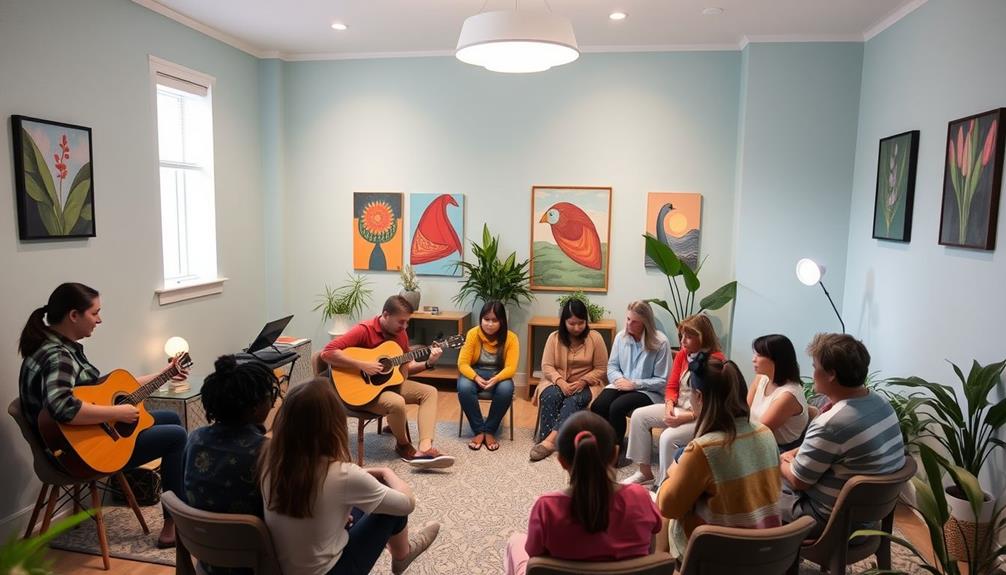Rhythm plays an essential role in your healing from trauma, acting as a bridge to emotional stability and connection. Engaging in rhythmic activities, like drumming or dancing, helps you navigate emotional turbulence and fosters a sense of safety. This innate response to rhythm strengthens your emotional regulation and enhances your social connections. Music-based interventions allow you to express feelings that words often can't capture. As you explore these practices, you may discover deeper insights into your healing journey and the transformative power rhythm holds for emotional recovery. There's so much more to uncover about this fascinating connection.
Key Takeaways
- Rhythm facilitates emotional processing and stability, aiding trauma survivors in navigating emotional turbulence.
- Engaging in communal rhythmic activities fosters connection, co-regulation, and shared healing experiences among individuals.
- Music-based interventions promote emotional expression, allowing individuals to articulate feelings beyond verbal communication.
- Tailored therapeutic programs leverage rhythm and melody to address individual trauma symptoms effectively and enhance emotional well-being.
- Evidence supports the effectiveness of rhythmic therapies in reducing stress levels and improving emotional regulation in trauma recovery.
Impact of Rhythm on Trauma
Rhythm acts like a lifeline for those grappling with trauma, helping you navigate the emotional turbulence that often follows such experiences. It plays a significant role in processing trauma by aiding your emotional regulation and re-establishing the inner coherence that trauma disrupts.
When you experience trauma, you might feel a breakdown in your sense of self, leading to chaos and disconnection. Engaging in rhythmic activities like singing, dancing, or drumming can create sensations of safety and stability essential for your recovery. Understanding how to manage BPD push-pull dynamics can enhance your ability to use rhythm for emotional healing.
These rhythmic activities not only foster a sense of connection with yourself but also with others. Participating in communal rhythmic activities promotes shared experiences that can help thaw frozen traumas, making it easier for you to reconnect with your emotions.
It's fascinating to realize that humans are biologically wired to respond positively to rhythm. From prenatal stages onward, rhythm serves as a universal nurturing tool that supports your emotional well-being.
Historical and Cultural Perspectives

Across various cultures and historical periods, the use of rhythmic music in healing practices has played a pivotal role in fostering emotional well-being. Indigenous cultures, for instance, have long utilized rhythmic music, particularly drums, in healing ceremonies, reflecting their rich cultural significance in community bonding. This emphasizes how rhythm fosters communication and strengthens community bonds.
In many societies, rhythmic music is intertwined with spiritual dimensions, reinforcing its importance in collective healing experiences. Ancestral knowledge underpins modern understandings of rhythm's therapeutic effects, showcasing a historical connection between rhythmic patterns and emotional health.
Practices like Gregorian Chanting and yoga recognized the healing benefits of rhythm as far back as the 11th century, highlighting its timeless relevance. Throughout history, the integration of rhythmic elements in healing traditions reflects a deep-rooted belief in rhythm as a universal nurturing tool.
This perspective suggests that rhythm isn't just a cultural artifact; it's an essential component for emotional regulation, starting from prenatal stages and extending through life. By acknowledging these historical and cultural contexts, you can appreciate how rhythmic music has shaped healing practices, providing a foundation for understanding its role in trauma recovery today.
Therapeutic Applications of Rhythm

Drumming circles and dance classes are more than just enjoyable activities; they serve as powerful tools for healing trauma. Engaging in rhythmic drumming, singing, or dancing can markedly enhance your emotional regulation while promoting a sense of safety.
These structured rhythmic movements are essential for maturing the brainstem, which plays a critical role in processing emotions and managing stress. Incorporating practices such as yoga for back pain management can further support your journey by enhancing physical well-being and emotional resilience.
Therapeutic applications of rhythm, such as Tai Chi and yoga, can also decrease anxiety and improve your overall mental health. They provide a sense of predictability and stability in your life, which is fundamental for healing.
When you participate in communal rhythmic activities, you foster connection and co-regulation with others, helping to thaw frozen traumas and strengthen social bonds.
Studies back the effectiveness of rhythmic interventions in addressing trauma-related symptoms, emphasizing their significance in holistic trauma-informed care.
Neurobiology of Rhythm and Healing

The neurobiology of healing trauma reveals how rhythmic interventions can profoundly impact emotional regulation and recovery. These therapies specifically target the brainstem and diencephalon, areas essential for processing trauma and regulating emotions. When you engage in rhythmic activities, like drumming, you provide repetitive sensory input that can reorganize brain-stem activity, effectively reducing anxiety and impulsivity.
Research in neurobiology supports the idea that trauma disrupts primal brain functions, leading to emotional dysregulation. Rhythmic therapies can help restore these functions, realigning homeostatic systems and fostering emotional stability. The table below summarizes key aspects of this neurobiological connection:
| Aspect | Impact on Trauma | Neurobiological Mechanism |
|---|---|---|
| Emotional Regulation | Reduces anxiety and impulsivity | Restructuring brain-stem activity |
| Homeostasis | Enhances emotional stability | Reorganizing neural pathways |
| Therapeutic Efficacy | Validated in recovery processes | Supported by neurobiological research |
Music-Based Interventions

Music-based interventions can help you express your emotions in ways that words sometimes can't. By incorporating AI in music creation into these programs, therapists can customize soundscapes that resonate with individual experiences, enhancing emotional responses.
Emotional Expression Through Music
Many people find that expressing emotions through music can be a powerful way to process trauma. Music-based interventions leverage rhythm and melody to help you connect emotionally, allowing feelings that are tough to articulate to flow freely.
Engaging with expressive arts can create a safe space for you to explore and communicate your innermost thoughts and experiences. The unique voiceover style used in National Geographic Channel voiceover ads enhances storytelling, much like music can enhance the narrative of your emotional journey.
These interventions have shown remarkable benefits, including stress reduction, enhanced emotional expression, and improved mood regulation. When you immerse yourself in music, it can facilitate a deeper emotional processing experience, making it easier to confront trauma-related symptoms.
The rhythmic elements of music act as a bridge, connecting your mind and body, which enhances overall therapeutic engagement. Evidence from various therapeutic contexts supports the effectiveness of music interventions.
They can be tailored to meet your unique needs and experiences, making them versatile tools in healing practices. By tapping into the power of music, you not only find a medium for expression but also open the door to healing.
Embracing this form of expressive arts can greatly aid your journey towards emotional recovery.
Tailored Therapeutic Programs
Personalized therapeutic programs harness the power of rhythm and melody to create meaningful emotional connections, making it easier for you to express and process trauma. With music-based interventions, you engage in a tailored experience that reflects your unique journey, allowing you to address trauma-related symptoms more effectively.
These programs often incorporate personalized elements based on your individual experiences, ensuring that the therapeutic approach resonates with your specific needs. Embracing heartbreak, as seen in the journey of healing, can also play a vital role in this transformative process.
Research shows that these interventions can lead to significant benefits, including stress reduction, improved emotional regulation, and enhanced social connections among participants. By integrating rhythm into your healing process, you tap into a long-standing tradition that fosters community bonding and personal growth.
You'll find that the rhythm not only supports your emotional expression but also encourages connection with others who share similar experiences.
As you participate in these tailored programs, you may discover new ways to articulate your feelings and confront your trauma-related challenges. This holistic approach empowers you, creating a safe space for exploration and healing while reinforcing the notion that you're not alone on this journey.
Embracing music as a therapeutic tool can profoundly impact your trauma recovery and overall emotional well-being.
Evidence of Positive Outcomes
Engaging in tailored therapeutic programs that incorporate rhythm and melody has shown notable promise in addressing trauma-related symptoms. Music-based interventions help you express emotions and relieve stress, particularly beneficial for those who've faced adverse experiences.
Additionally, engaging in activities that encourage creativity, such as structured play, can further enhance emotional expression and help individuals process their feelings. Research highlights that rhythmic and melodic elements create strong emotional connections, which are vital for effective trauma recovery.
Studies indicate that these tailored music programs can appreciably enhance emotional regulation, helping you manage the aftermath of trauma. Practitioners have observed that, as van der Kolk noted, rhythm plays a significant role in improving mental health outcomes.
You might experience a reduction in anxiety and impulsivity linked to your trauma through these interventions. While some argue for more rigorous scientific validation, experiential knowledge and client feedback consistently affirm the value of music therapy in trauma care.
The positive outcomes seen in various therapeutic settings suggest that integrating music into your healing process can be a powerful tool. By participating in these programs, you're not just listening to music; you're actively engaging in a healing journey that leverages rhythm to foster recovery and emotional well-being.
Practitioner Insights and Experiences

As you explore the insights of practitioners using rhythmic techniques, you'll find their experiences reveal powerful transformations in clients.
Many practitioners emphasize the importance of incorporating mind-body connection to enhance the effectiveness of rhythmic methods in trauma healing.
They often share innovative methods that blend rhythm with traditional therapies, creating a more holistic approach to trauma healing.
Practitioner Experiences With Rhythm
Practitioners working within trauma-informed care often find that rhythmic activities, both in individual and group settings, create a unique environment conducive to healing. Incorporating rhythm, such as through drumming and dancing, can greatly enhance emotional regulation and foster a sense of safety for trauma survivors. Many therapists advocate for these rhythmic interventions, noting the positive feedback from clients about their emotional experiences during sessions.
By fostering curiosity in sessions, practitioners can further engage clients, encouraging exploration of their own emotional landscapes. Collaborative rhythmic experiences, like group drumming, amplify the therapeutic effects of co-regulation and connection among participants. This shared rhythm helps thaw frozen traumas, allowing individuals to reconnect with their emotions.
Practitioners also observe that rhythmic movement activities effectively decrease anxiety and impulsivity. By targeting the brainstem, these activities promote neural reorganization, creating a pathway toward healing.
Continuous professional development in trauma-informed care is essential for you as a practitioner. Staying informed about innovative rhythmic approaches enables you to integrate these techniques into your therapeutic practices.
As you embrace the power of rhythm, you'll likely witness profound transformations in your clients, fostering resilience and healing through the rhythmic pulse of life.
Innovative Techniques in Practice
Rhythmic activities are continually evolving in therapeutic settings, leading to innovative techniques that practitioners are excited to share. You'll find that many therapists now use drumming and dancing not just as forms of expression, but as vital tools for enhancing emotional regulation. These rhythmic activities can create a sense of safety, essential for trauma recovery.
Additionally, music-based interventions are becoming popular. They're designed to build emotional connections and foster self-expression among clients. One notable approach is Bruce Perry's rhythmic movement techniques, which effectively calm the nervous system and help address trauma-related symptoms.
Collaboration is key in this field. Music therapists and mental health professionals work together to integrate these rhythmic interventions, ensuring a holistic approach to trauma care. Ongoing professional development is vital too, as practitioners prioritize training in trauma-informed care to deepen their understanding of rhythmic methods.
| Technique | Purpose | Benefit |
|---|---|---|
| Drumming | Emotional regulation | Enhanced safety |
| Music-based interventions | Facilitate self-expression | Emotional connection |
| Rhythmic movement | Calm the nervous system | Trauma symptom relief |
Future Directions in Research

Exploring the future of research on rhythm in trauma healing promises to reveal new avenues for therapeutic practices. As you investigate this field, you'll find that validating existing methods is essential. Establishing standardized measures for evaluating outcomes will enhance the effectiveness of rhythmic interventions. In addition, delving into the science of sound therapy may uncover the underlying mechanisms by which rhythm can impact the brain and body in trauma healing. This understanding could lead to the development of more targeted and personalized interventions, ultimately improving the overall outcomes for individuals seeking healing from trauma. By combining the exploration of traditional rhythmic practices with the latest advancements in neuroscience, the future of research on rhythm in trauma healing holds great promise for advancing therapeutic techniques.
Additionally, understanding the impact of mental health support on overall healing can provide valuable insights into therapeutic strategies.
You'll also discover the value of examining diverse cultural contexts. Different healing traditions offer unique perspectives on how rhythm can be utilized, enriching your understanding and potentially broadening the scope of therapeutic practices.
Interdisciplinary collaboration is another exciting direction. By working alongside mental health professionals and music therapists, you can develop innovative approaches that integrate rhythm with other modalities, making trauma treatments more thorough.
Moreover, there's a growing call for advocacy to increase awareness and funding for music therapy programs that incorporate rhythmic elements. This push can lead to more resources for those seeking trauma recovery.
Frequently Asked Questions
What Is Rhythmic Healing?
Rhythmic healing's all about using repetitive activities like drumming and dancing to enhance emotional well-being. You engage your body and mind, promoting calmness and safety, which can lead to profound emotional recovery and resilience.
How to Remove Trauma From the Body?
Imagine you're shaking off a bad hangover. To remove trauma from your body, engage in rhythmic activities like dancing or drumming; they'll help release pent-up emotions and restore your sense of safety and stability.
How to Heal the Nervous System From Trauma?
To heal your nervous system from trauma, focus on activities that promote relaxation and safety. Engage in deep breathing, yoga, or gentle movement. These practices can help restore balance and support emotional regulation effectively.
What Is the Role of Music in Healing Trauma?
Imagine jamming with friends around a campfire; that's how music heals trauma. It connects you emotionally, helps you express feelings, and calms your nervous system, making it an essential tool for recovery and growth.
Conclusion
Incorporating rhythm into healing practices can truly be a game changer for those dealing with trauma. It taps into our innate ability to connect, process emotions, and find solace. As you explore music-based interventions and the neurobiological underpinnings, remember that the past shapes who we are, but it doesn't have to define our future. By embracing rhythm, you can pave the way for transformation and resilience, helping yourself and others move forward in a profound way.










